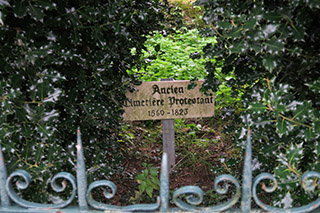Prochain point : lat="" lon=""
THE OLD PROTESTANT CEMETERY
Protestant ideas in Vexin
The Reformation…
The protestant reformation developed in the 16th century. The Roman Catholic church claimed to have sole authority to interpret scripture and establish doctrine under the auspices of a supreme leader: the Pope. The Catholic Church sold indulgences to the faithful so that they could win God’s favour. The sale of indulgences deeply divided christians and gave rise to a dubious economy. The Reformation movement aimed to take Christianity back to its source. Reformers used the development of the printing press to distribute bibles in vernacular languages, demonstrating that it mentions neither saints, nor the worship of the Virgin Mary, nor purgatory. New churches were formed on a different model than that of the Catholic Church, with a greater emphasis on the Bible and its study. Europe was divided between supporters of the Reformation and the Protestant Church, and the Roman Catholic Church.
…and John Calvin (1509 – 1564)
After studying philosophy and law, Calvin broke away from the Roman Catholic Church around 1533 to become a theologian, preacher and polemicist. He took refuge from persecution against French Protestants in Switzerland. He published the first edition of “Institutes of the Christian Religion” in Basel in 1536, a treatise in which he defends his faith and presents the doctrine of the Reformation. Anxious to promote the Reformation in France, he supported the building of protestant churches and trained clergymen.
Contrary to legend, the name of the hamlet, Enfer (the French word for hell), is not linked to a visit by Calvin to the Chateau of his friend the Lord of Hazeville, in 1534. It would in fact appear that Calvin never set foot in Vexin, and certainly did not visit the Chateau, which was built in 1560. Burials took place in the small protestant cemetery called the “Cimetière des Huguenots” (the Huguenot cemetery) from 1560 to 1823.

 >
>

